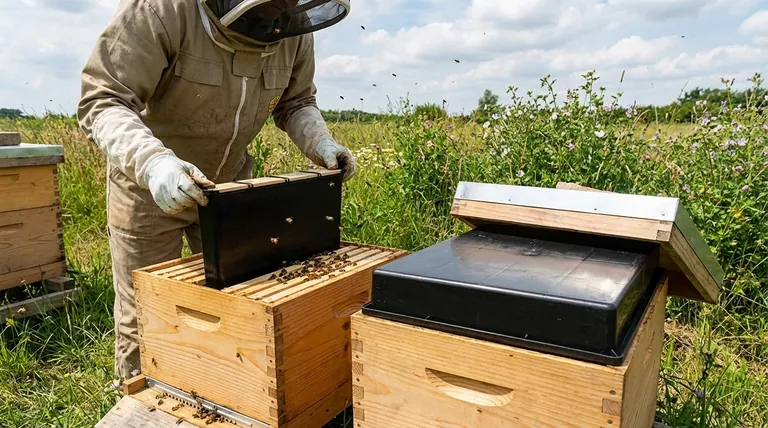The fundamental difference between a frame feeder and a top feeder is its placement and how that impacts the bees and the beekeeper. A frame feeder hangs vertically inside the hive, taking the place of one or two frames, while a top feeder sits horizontally on top of the uppermost hive box, just beneath the outer cover.
The choice between a frame feeder and a top feeder is a strategic decision based on your goals. Frame feeders offer better protection and insulation for the syrup, while top feeders provide unmatched capacity and convenience for the beekeeper.

A Closer Look at Frame Feeders
Frame feeders, also known as division board feeders, are containers shaped like a standard hive frame. They are placed directly inside the brood box or super, in close proximity to the bee cluster.
How They Work
The feeder replaces one or two frames, and the beekeeper fills its reservoir with syrup. Bees access the syrup from the top edge of the feeder, often with the help of integrated ladders or floats to prevent drowning.
Key Advantage: Protection
Because the syrup is entirely contained within the hive, it is protected from rain, wind, and cold temperatures. This also significantly reduces the risk of attracting pests or robber bees from nearby hives.
Key Advantage: Warmth and Accessibility
The syrup stays at the ambient temperature of the hive interior, making it more appealing and easier for bees to consume, especially during cooler weather. This makes them ideal for stimulating growth in the spring or feeding during inclement weather.
Understanding Top Feeders
Top feeders are large-capacity containers placed on top of the hive bodies but underneath the telescoping outer cover. They come in various styles, from simple inverted buckets to more complex trough designs.
How They Work
Bees travel up from the frames below to access the syrup through a central opening or screen. The beekeeper can refill the feeder by simply removing the hive's outer cover, causing minimal disturbance to the colony.
Key Advantage: Massive Capacity
Top feeders can hold a gallon or more of syrup. This is their primary advantage, as it allows beekeepers to provide a large amount of food at once, reducing the frequency of apiary visits.
Key Advantage: Efficiency for the Beekeeper
Refilling a top feeder is fast and requires little disruption to the brood nest. This makes them highly efficient for managing many hives or for apiaries located far from home.
Understanding the Trade-offs and Risks
Neither feeder is perfect, and each comes with potential downsides that must be managed.
The Risk of Drowning
Both feeder types present a drowning risk to bees. Well-designed frame feeders include plastic floats or textured inner walls to give bees a safe place to stand. Similarly, top feeders must have adequate ladders or floats for bees to access the syrup safely.
Hive Inspection and Access
A frame feeder must be removed to perform a full hive inspection, which can be cumbersome and messy if it's full of syrup. A top feeder sits outside the main hive bodies and does not interfere with frame manipulation.
Impact of Weather
A top feeder is more exposed to outside temperatures. In cold weather, the syrup can become too cold for bees to consume, rendering it useless until the weather warms. Frame feeders do not have this problem.
Making the Right Choice for Your Goal
Selecting the best feeder depends entirely on your beekeeping objectives and environmental conditions.
- If your primary focus is stimulating a new package or feeding during cool, unpredictable spring weather: A frame feeder is superior because it keeps the syrup warm and protected.
- If your primary focus is heavy fall feeding or managing distant apiaries with minimal visits: A top feeder is the ideal choice due to its large capacity and ease of refilling.
- If your primary focus is minimizing the risk of robbing from other hives: A frame feeder is the safer option as it contains the syrup's scent within the hive.
Ultimately, choosing the right feeder is about aligning the tool with your specific beekeeping strategy and environment.
Summary Table:
| Feature | Frame Feeder | Top Feeder |
|---|---|---|
| Placement | Inside the hive, replaces frames | On top of the hive, under the cover |
| Primary Advantage | Syrup protection & warmth for the bees | Large capacity & convenience for the beekeeper |
| Best For | Spring feeding, cool weather, preventing robbing | Heavy fall feeding, distant apiaries, large-scale operations |
| Key Consideration | Must be removed for hive inspections | Syrup can be affected by cold external temperatures |
Ready to choose the right feeder for your apiary?
As a trusted wholesale supplier to commercial apiaries and equipment distributors, HONESTBEE provides durable, high-capacity feeders designed for professional beekeeping success. Our products help you manage your colonies more efficiently, whether you need the protective warmth of a frame feeder or the large-scale convenience of a top feeder.
Let's discuss your feeding strategy and scale your operation. Contact our expert team today to request a quote or learn more about our wholesale beekeeping supplies.
Visual Guide

Related Products
- Professional In-Hive Frame Bee Feeder by HONESTBEE
- Professional Hive Top Bee Feeder for Beekeeping
- 3.5L Plastic Beehive Frame Feeder Deep Frame Water Feeder for In Hive Use
- HONESTBEE Professional Hive Top Bee Feeder Feeding Solution
- Professional Hive Front Entrance Bee Feeder
People Also Ask
- What is a frame feeder? A High-Capacity, Secure In-Hive Feeding Solution
- What is a frame feeder and how does it work? An Efficient In-Hive Feeding Solution
- What are the advantages of using a frame feeder? Boost Hive Health with In-Hive Feeding
- How do I keep bees from drowning in my frame feeder? Essential Tips for a Safe Hive
- Are frame feeders good? Maximize Your Hive's Health with the Right Feeding Strategy



















